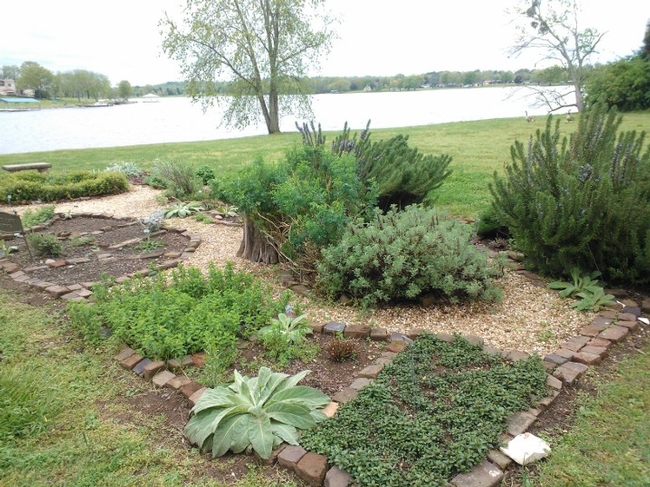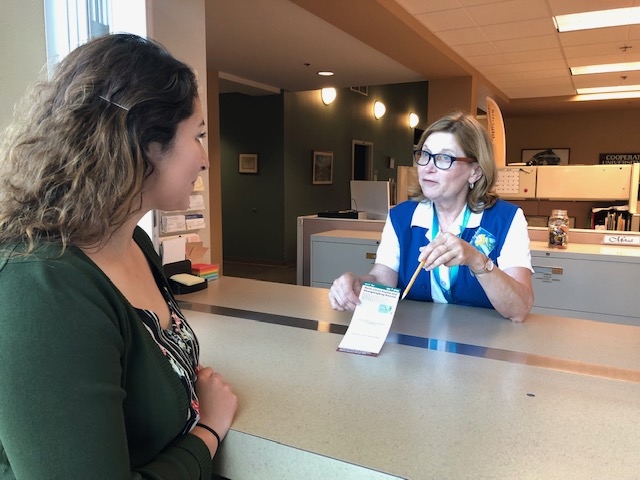
Maybe you are wondering how to prevent squash bugs from ruining your zucchini plant, what to do when powdery mildew shows up, or how to prune your fruit tree. We also answer questions such as, “What trees make the best shade trees?” or “Can you recommend some California native plants that would thrive in my backyard?” or even, “What's your favorite peach variety to grow?”
No matter what question you have, the UCCE Stanislaus County Master Gardeners can help! We are not currently working from our office; however, we are available to answer them remotely.
3 Ways to Contact Us
- Fill out our online form (you can also upload photos) http://ucanr.edu/ask/ucmgstanislaus
- Call (209) 525-6802 on Wednesday, between 9 a.m. to noon to speak to someone.
- Leave a voice message anytime and we will return your call within 2 business days.
Our goal is to get back to you within 48 hours.
If you reside in another county, visit http://mg.ucanr.edu/FindUs/ to find your program. For other states, visit https://ahsgardening.org/gardening-resources/master-gardeners/
[From UC IPM's Pests in the Urban Landscape Blog]
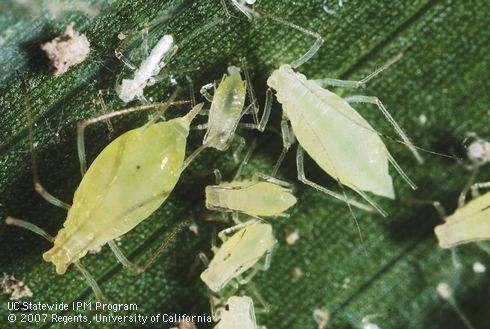
At some point, all of us encounter a pest in our home, garden, or landscape. But you're not alone! UC IPM publishes Pest Notes – a series of more than 150 papers reviewed by experts in the field – to provide science-based information about pests and their management.
These ten Pest Notes were the most frequently viewed online in 2019, with more than 330,000 total pageviews. While it's not a contest, we like to think these are the winners of 2019's most popular pests.
1. Aphids
These small, soft-bodied insects can multiply rapidly, especially in warm weather. Many species exist in California, feeding on vegetables,flowers, fruit trees, and woody ornamentals. Their sticky honeydew encourages growth of sooty mold, while their feeding can distort growth or transmit viruses from plant to plant. Managing ants and supporting natural enemies are two ways you can reduce aphid damage. Learn more about aphids and their manaent in the Pest Notes: Aphids.
2. Thrips
Thrips are tiny, slender insects about the size and shape of a dash printed in a newspaper. Some are beneficial predators that feed on other insects and mites. But most feed on plants, sucking out the cell contents, leaving a discolored speckling on leaves or stunting plant growth. An integrated approach is recommended for management, incorporating good cultural practices, natural enemies, and least-toxic insecticides if needed. For more about thrips monitoring and management, visit our Pest Notes: Thrips.
3. Peach Leaf Curl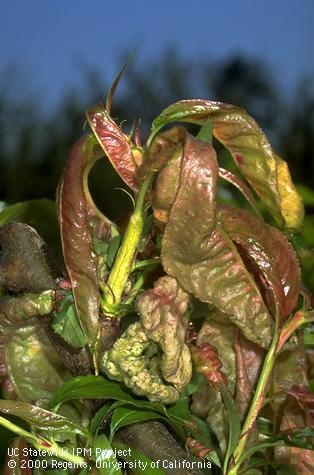
Peach leaf curl can affect the blossoms, fruit, leaves, and shoots of peach and nectarine trees. The symptoms of the disease first appear in spring, when distorted red foliage emerges. However, focus management for nonresistant varieties in the late fall and early winter, after leaves drop. Read more about this disease in our Pest Notes: Peach Leaf Curl.
4. Scales
Scales are small, legless insects that look like tiny scabs on the stems, leaves, or fruit of plants. While some scale species can weaken a plant when abundant, other species do not appear to damage plants at all. Think you have a problem with these insects? Visit our Pest Notes: Scales for identification and management options.
5. Fungus Gnats
This pest was surprising to find in this year's top 10. Fungus gnats are small flies that often infest soil and potting mixing, emerging from indoor houseplants and becoming a nuisance. The larvae, or immatures, can damage roots and stunt plant growth when present in large numbers. If you do see these flies flitting about, sticky traps may be effective in reducing the problem. However, the presence of gnats and decline of house plants are more commonly due to too much or too little water and improper soil conditions. More information on these frustrating flies can be found in our Pest Notes: Fungus Gnats.
6. Mealybugs
If you've found soft, oval insects that are white in color with wax filaments on your plants, it is likely you have mealybugs. These wingless insects are often found in clustered colonies on indoor and outdoor plants. In yards and gardens, handpicking, pruning, or high-pressure water sprays can reduce populations. For small infestations indoors, spot treatments may help reduce populations. For houseplants with severe infestations, consider disposing of the plant. Find additional information in Pest Notes: Mealybugs.
7. Opossum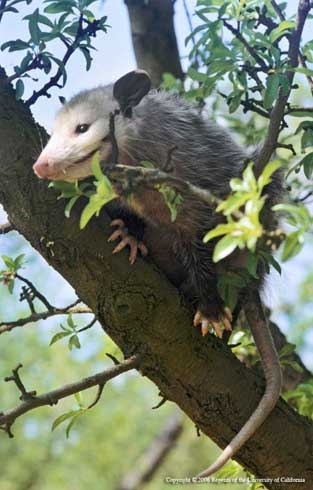
In residential areas, this not so mysterious marsupial will take up residence under porches, decks, garden sheds, attics, and basements. Opossums are nocturnal omnivores, foraging for fruits, nuts, plants, insects, snails, and even small mammals such as mice. In addition to being a nuisance in residential areas, they carry various diseases that can be transmitted to humans including tuberculosis, spotted fever, and typhus. The best control for opossums is to screen or block access to areas where they may den. You may also choose to hire a professional wildlife control operator to trap and dispense of any opossum visitors. Pest Notes: Opossum has more on the biology and management of these animals.
8. Carpet Beetles
Carpet beetle adults are typically brought into the home on cut flowers or when they fly in through open doors, windows, or holes in screens. The immature beetles feed on animal products such as wool, silk, leather, fur, and hair. Regular cleaning of rugs, upholstered furniture and closets as well as eliminating accumulations of lint, hair, and other debris is an important preventive measure. Check out the Pest Notes: Carpet Beetles for more preventive and management methods of these pests.
9. Ground Squirrels
Ground squirrels are troublesome rodents found throughout most of California. Their network of burrows can be extensive, damaging trees, lawns, and structures. Ground squirrels can also damage many food-bearing and ornamental plants in yards and gardens. For legal management methods, see our Pest Notes: Ground Squirrels.
10. Whiteflies
Whiteflies are not actual flies but are tiny insects that are often found on the underside of leaves, feeding on the phloem of many different plants. Certain species can cause significant loss in vegetable gardens; other species found in fruit trees are less damaging. In home gardens, reflective mulch can repel whiteflies and yellow sticky traps can reduce numbers of high infestations. Additional management information can be found in Pest Notes: Whiteflies.
- Author: UC IPM
Tis the season for holiday travel. As you make reservations for rental accommodations to visit family and friends, we wanted to share a few suggestions to help you avoid bringing bed bugs home with you. Regardless of what type of lodging you choose-- hotel, motel, cabin, or other type of rental-- no place is immune to bed bug introductions or infestations.
We don't wish to alarm you, but we do want to point out that bed bug infestations are on the rise in the United States. Take precautions to save yourself from later issues and costs in case bed bugs do find their way into your home.
When settling into your room
- Before plopping your luggage down on the bed, couch, or floor, we recommend doing a quick bed bug check of the room. You can either leave the luggage in the hall or place it in the bath tub, where bed bugs are not likely to be. Traveling with the family? Let them and all the luggage sit comfortably in the lobby while you do the room inspection.
- Do a thorough inspection of the bed, night stand, upholstered furniture, and closets. You can use a flashlight or a phone light to help you look for bed bugs, shed skins, or fecal matter.
- Some establishments use bed bug mattresses and box spring encasements. These can make it easier to detect bed bugs or be used as a preventative measure.
- Not sure what you are looking for? We created this video to show you what bed bugs look like and how to search for them.
After You Return Home
- Before you bring luggage back into the house, inspect it for any signs of bed bugs that may have hitched a ride. Store luggage away from the bedroom to prevent potential introductions.
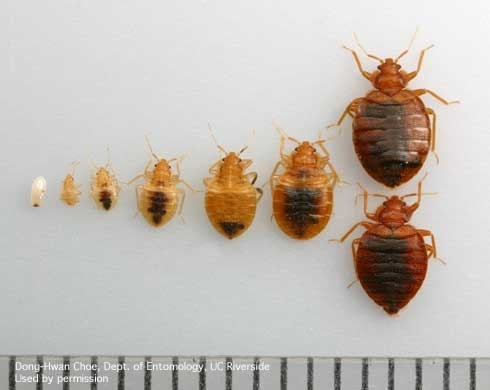 Egg, immature bed bugs, adult bed bugs. (DH Choe)
Egg, immature bed bugs, adult bed bugs. (DH Choe) - To be cautious, launder all the clothes from your trip on the hottest settings to kill bed bugs that may have gone unnoticed. For items that cannot be washed, freezing them for several days will also kill bed bugs.
- If you do find bed bugs, these steps will help reduce the risk of infestation. See more about identification and management in our Pest Notes: Bed Bugs
Follow these tips to enjoy your holiday travel, reduce your risk of getting bitten by bed bugs, and not bringing bed bugs home with you.
Staying home for the holidays? Here are some tips to host a bed bug-free holiday!
- Author: Anne E Schellman
The University of California Cooperative Extension (UCCE) Master Gardeners of Stanislaus County are teaching a free Managing Pests in Your Vegetable Garden class on Thursday, July 18, 2019 from 6:00-7:30 p.m. at the Agriculture Center on 3800 Cornucopia Way in Modesto at Harvest Hall, Rooms D&E.
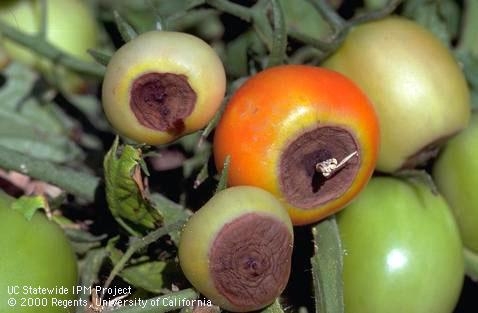
Join us for a free class about common pests that plague warm-season vegetable gardens. Learn how to identify insects, diseases, and weeds and how to control them using less-toxic methods.
This family-friendly class is open to everyone. Participants will receive free seeds (while supplies last). Our instructor for the class is Ed Perry, Environmental Horticulture Advisor (emeritus) for Stanislaus County. This class is free, but please visit http://ucanr.edu/vegpests2019 or call Anne Schellman at (209) 525-6862 to sign up. Space is limited, so please reserve your seat today.
If you haven't already, please “like” us on Facebook and Twitter @UCMGStanislaus so you never miss an announcement for a class or workshop.
- Author: Anne E Schellman
Stanislaus County herb gardening enthusiasts attended a free class on Thursday, April 11, 2019 from 6:00-7:30 p.m. from the UCCE Master Gardeners.
Attendees learned the basics on how to grow herbs from seed or transplant, and how to recognize various herbs by scent and sight by looking at examples. See if you know the answers to this "Pop Quiz" given during class:
Question#1: "What is the difference between an herb and a spice?"
Question#2: "Can you name a plant that is both an herb and a spice?"
Answer#1: The herb is the leafy part of the plant, while a spice may be the bark, seeds, or plant roots (cinnamon, mustard, or ginger).
Answer#2: Cilantro is both an herb and a spice (coriander).
Here are a few other fun facts discussed during the class:
- If you want a continuous supply of annual herbs like basil, dill, and cilantro, plant from seed every 2 weeks during the growing season.
- Tiger swallowtail butterfly caterpillars eat dill and fennel.
- You can propagate some leafy herbs by pulling off the bottom leaves of a stalk and placing them in water (mints, lemon balm).
- Chamomile and chive seeds need light to germinate. Sprinkle them on top of the soil and lightly water.
- Spearmint, peppermint, and lemon balm can quickly take over a garden space. Keep them contained in pots.
- Fennel is an invasive weed that can cause economic damage to agriculture and the environment. Avoid planting if you live around farms or open spaces.
- Pests also like herbs! If you have damage on your plants, bring in a sample to the UCCE Master Gardeners for help.
Future Events
How to Select, Plant, & Prune Landscape TreesSaturday, April 27, 2019 9:00 am to noon ($10) register now! http://ucanr.edu/trees2019
Coming This Summer and Fall
Low Water Landscaping
Pest Management In & Around the Home
Attracting Pollinators to Your Garden
Fall Vegetable Gardening for Beginners
Please visit http://ucanr.edu/scmg to see class updates.


